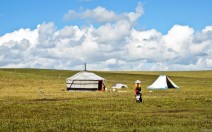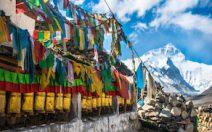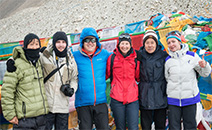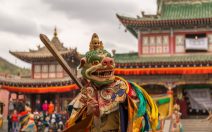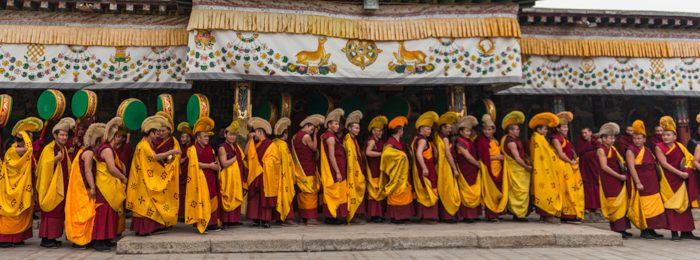Throughout the history of Buddhism there have been many practitioners for whom the communal life of a monk has come to seen as an obstacle to their spiritual goals. Leaving the security of the monastery behind, they have often ventured into the wilderness, taking up an abode in remote locations where they can remain in self-imposed isolation. In doing so, these practitioners aim to sever the ties that bind them to the realm of samsara and achieve the final insight which leads to liberation from all suffering.
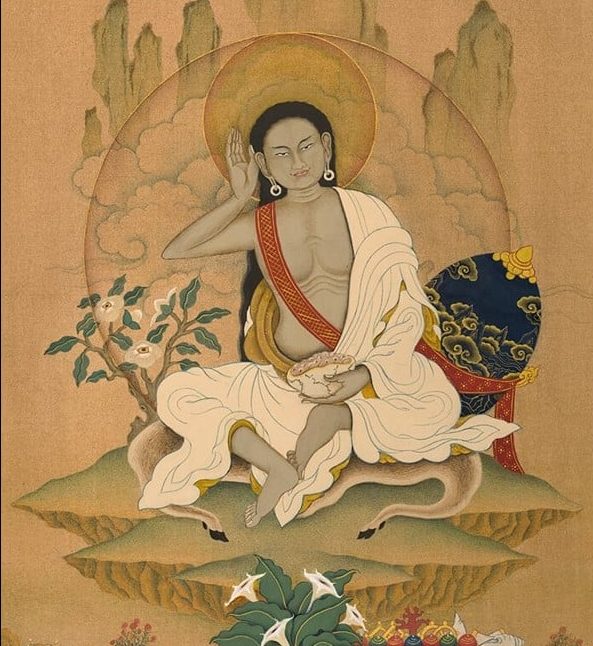
Such spiritual adepts are called yogis.
In contrast to the uniform appearance of monks, the yogi is not bound by the common requirements of monastic discipline. Some grow their hair long. Others may even discard the maroon coloured robes of a monk.
Perhaps the most famous yogi in Tibetan history is Milarepa (1040-1123).
Milarepa was born to Mila Sherab Gyeltsen and Nyangtsa Kargyen, a prosperous farming couple, who resided in Kya Nangtsa near the border with Nepal. Named after his father, Mila, the initial years of his life were comfortable and happy. Yet this all changed when, at age seven, his father died. Although his uncle, Yungdrung Gyaltsen, had initially sworn to take care of Mila and Nyangtsa Kargyen, he soon took possession of the family’s estate. Denying Mila and his mother their inheritance, he forced Mila’s mother and his sister to work as servants.
Seeking revenge for their suffering, Mila’s mother sent him to learn black magic. Mila sought out a renowned sorcerer, Yungton Trogyal, who had learned the ability to cast hailstorms from another sorcerer, Nupchung Yonten Gyatso. Yungton Trogyal first sent him to study with Nupchung Yonten Gyatso. It was from this master of sorcery that Mila learned how to cast a spell which killed the guests who were attending a wedding feast at his uncle’s house. Mila then learned how to summon hailstorms from Yungton Trogyal. Returning to his home region he cast a devastating storm which destroyed the year’s harvest. In this way, Mila successfully gained his revenge on those who had wronged him and his family.
However, such terrible acts did not bring him any satisfaction. Instead, Mila felt remorse for his deeds. In order to atone for his crimes, he renounced the use of black sorcery and sought out a lama who would guide him on the correct path towards enlightenment.
Eventually he met Marpa Chokyi Lodro (c.1002-1097), a married lama who had previously travelled to India and Nepal in order to receive teachings from both monastic and yogic masters, including the Indian siddha, Nāropa. A stout man who was prone to drunken outbursts, Marpa initially mistreated Mila. He would beat the young man, often to the point of knocking him unconscious, belittle him, and allowed him only the bare necessities of food. In an attempt to break Mila’s spirit, Marpa also forced him to build stone towers and then pull them down, only to rebuild them once more.
A principle feature of Sekhar Gutok monastery in southern Tibet is a nine storey tower, said to be have been one of the towers built by Mila for Marpa. The tower of Mila as an architectural feature can also be found in another Karma Kagyu monastery in Amdo, Sirin Kar.
Finally, after putting Mila through such trials, Marpa revealed to him that the reason for subjecting him to these methods was to help Mila atone for his crimes of murder and black sorcery. Having endured them without giving up and seeking another master, Mila was now ready to receive his teachings.
Marpa instructed Mila in the traditions he had received from Nāropa and other Indian masters. Marpa prepared his student for a life of asceticism by teaching him secret meditational practices, including tummo, the ability to retain one’s body heat while meditating in extremely cold climates. Through his tutelage under Marpa, Mila came to realise the futility of a life attached to the sensual pleasures of the world. After completing his training, he devoted himself to a life of asceticism and meditation. Renouncing both communal society and the disciplined life of a monk, he ventured into the mountains.
Throughout the Himalayan region of southern Tibet and Nepal there are numerous sites where Mila performed his ascetic retreats. During his years of living in isolation, he sustained himself by eating only soup made from wild nettles. As a result of this, his skin eventually took on a shade of green. It is for this reason that he is often portrayed in paintings with green skin. Wearing only a white cotton robe, he came to known as Milarepa (Mila, the cotton clad).
Through the virtue of his practice, Milarepa managed to attain enlightenment in a single lifetime. As well as his meditational practices, he also gained notoriety for his songs of realisation. These songs are still sung today and tell of the trials he encountered on his path to awakening. He also took numerous disciples, including Gampopa (1079-1153). It was Gampopa who blended the yogic practices of Milarepa with the codes of monasticism and from this syncretic model the Kagyu tradition of Tibetan Buddhism developed.
Death eventually came to Milarepa at age 84 after eating a poisoned meal prepared by a monk who was jealous of his abilities. Yet when the monk realised the error of what he had done, he took Milarepa as his own master and vowed to never sin again.
The yogic practices of Milarepa still continue to influence the various suborders of the Kagyu tradition and it is customary for Kagyu monks to undertake a three-year retreat in isolation before they can qualify as lamas.
